#CBRN Training
Explore tagged Tumblr posts
Video
#JBSA#Joint Base San Antonio#Lackland#AETC#Air Education and Training Command#PACER FORGE#BMT#Gas chamber#CBRN#flickr
6 notes
·
View notes
Text

US Army CBRN training
139 notes
·
View notes
Text

Enabling the ChemWarrior to execute his assigned mission in a zone contaminated by nuclear, chemical or otherwise lethal combat warfare agents requires the use of special combat equipment. This mainly includes that those soldiers are trained to permanently wear a heavy hermetically sealed combat protective suit while on their dangerous missions. This specific uniform of course is quite a burden as it hinders movements, sweat evaporation, breathing and hydration. Therefore getting used to breathe against the resistance of a heavy combat approved filter, to live on liquid nourishment for days only and with limited opportunities to hydrate through the face masks liquid input port while constantly wearing the heavy ballistic protection equipment such as combat helmet and plate carrier are the first tasks of every ChemWarrior recruit. But only this will later allow to go on several days long top secret reconnaissance missions or sabotage or open combat missions during a cbrn warfare scenario. Keep up good mood and breathe steadily.
46 notes
·
View notes
Text

A U.S. Marine assigned to Chemical Biological Radiological and Nuclear (CBRN) Defense School conducts a contamination test during a field training exercise at Fort Leonard Wood, MO.
Lance Cpl. Manuel Serrano / US Marines, May 12, 2016
8 notes
·
View notes
Note
For the uneducated jerk off who thinks “masks work”- I can tell you for a fact, as a someone who takes CBRN recurrent training each year, unless you wear something like a gas mask that seals off you eyes, nose and mouth, while using and regularly changing the appropriate filters, you’re not protecting anything. That bullshit mask on your face is doing absolutely jack fucking shit. The only thing ghat mask is doing is virtue signaling.
But that’s not what the TV told them!!
30 notes
·
View notes
Text
oc lore - the resistance
Basically vaguely militarized first responders
each squad has a captain and a S.I.C. (second in command). Squads differ depending on their purpose and each member of a squad (usually around 5 people) can have multiple specialties.
The main branches of the Resistance are:
Public Security - Basically contains the police, public defendants, and detectives (etc.). Has a BUNCH of sub-branches including, but not limited to: - PSRC - Pub. Sec. Riot Control, Kinda obvious but handles riots. - PSDD/PSIS - Pub. Sec. Department of Detectives/Pub. Sec. Investigative Services, Detectives. - PSCN - Pub. Sec. Crisis Negotiators. etc.
EMFRS - Stands for Emergency Medical and/or Fire Response Services. Basically paramedics and firefighters combined into one team.
CBRN Threat Response Force - handles chemical, biological, radiological, or nuclear threats. Split into multiple different sub-branches, the main one being Primary Response (aka first responders on a scene if chems are involved). List of the ones (so far) are: - Primary Response - professionals trained in rapid-response relief efforts. The more experienced responders. - AFA - Affect-Effect Assembly, professionals trained in the ‘what now’, specifically for after attacks. - Preventative Motions Assembly - members more in the legal side of it, trying to outlaw chemical, biological, radiological, or nuclear weapons. - CBRNRC - CBRN Riot Control, basically they’re on standby at any site where they may be a violent confrontation that ends with the usage of chemical weapons. Works closely with PSRC.
NDAA - Natural Disaster Aid Assembly, handles any result of any natural disaster. The most funded aspect of the Resistance.
Removers - The anti-abstractions unit. Groups of people (often separate from most squads) sent into Outbreak Zones to combat the Abstractions.
Logistics - Help people evacuate, create tactics, and handle finances
Medical Corps - The medical personnel. Split into many sub branches but some are: - Paramedics - part of EMFRS (under both Medical Corps and EMFRS). First responders to civilian disputes in non-violent areas. - Combat Medics - NOT part of EMFRS. Medics on the field, highly trained and skilled. Respond to civilian disputes in violent areas. - Field Hospital Staff - Doctors and Surgeons, handle treatment at hospitals. - RCWAMP - Recovery from Chemical Weapons Assistance Medical Personnel. Basically the team behind assisting any being injured in a CBRN attack. Work VERY closely with the CBRN Threat Response Force. - MHAP - Mental Health Assistance Personnel, therapists and psychiatrists
RESpecOp - Resistance Special Operations. The most militarized aspect of the Resistance. Handle scouting, sniping, data analysts, etc. has multiple subbranches a few of them are: - RSOS - RESpecOp Snipers. Kinda obvious, I’d say but snipers! - RSOSC - RESpecOp Scouts. Handle scouting. Has subbranches but a good portion of them work with the Removers branch. RSODA - RESpecOp Data Analysts. Analyze data from operations, create graphs, verify data, and assist with the planning of future operations. RSOIG - RESpecOp Intelligence Gatherers. Gather the intelligence. Different from Data Analysts as they’re the gathering the information in the first place, and tend to provide real-time updates for teams on the field.
this will be updated later on as the story progresses but! :p
2 notes
·
View notes
Text

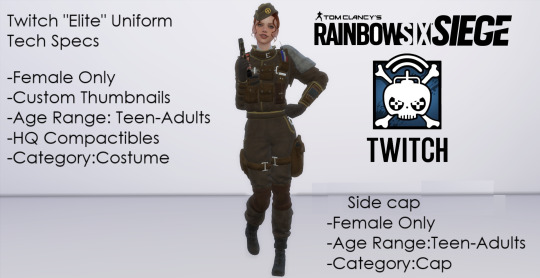


Rainbow 6 Siege Twitch +Elite Twitch
@cctreasuretrove @sssvitlanz
Emmanuelle Pichon, codenamed Twitch, is an Attacking Operator featured in Tom Clancy's Rainbow Six Siege Pichon grew up in a family of academics in the historic city of Nancy, France, where the children were encouraged to excel in Math, Science, and Technology. Early participation in sponsored computer programming competitions led to her joining the army cadets at sixteen. Almost immediately her talent was recognized, particularly in robotics. Her superiors quickly encouraged Pichon to study engineering while continuing her career in the military with the GIGN. From the start, Pichon's focus has been on adaptable technology that aids soldiers in the field. While there is much praise for her technological achievements, Pichon's tactical prowess and ability to problem solve quickly and efficiently make her a crucial operational asset.
In 2015, Pichon was led by Olivier "Lion" Flament on a mission to Nigeria to assist medical personnel fighting the Ebola epidemic. Tragedy ensued, and the decisions Flament made for safety reasons put him at odds with Pichon and Gustave "Doc" Kateb, who blamed him for the death of several medical personnel on-site including Kateb's colleague. Later that year, Pichon's unique combination of talents made her well-suited to join Rainbow.
In 2016, Pichon met Taina "Caveira" Pereira and had some kind of relationship with her, but to what extent remains currently unknown. While not deployed on missions, Pichon proved invaluable for Rainbow's R&D Department. She assisted in the improvement of the team's equipment and was noted to have helped Elena "Mira" Álvarez in the development of Morowa "Clash" Evans' CCE Shield in 2017. In early 2018, Pichon assisted Rainbow's new CBRN Threat Unit with a situation concerning a mysterious mist on the shores of Sussex. During the operation, Pichon provided Olivier Flament with a new aerial drone that allowed him to determine the source of the mist plume. In 2019, Pereira went AWOL in Bolivia in order to search for her brother. Pichon and Meghan "Valkyrie" Castellano subsequently collaborated with Ghost Recon to conduct Operation Archangel in order to recover Caveira which proved to be a success.
In June 2020, Pichon and Julien "Rook" Nizan were in Paris, France when two large fires emerged downtown. The GIGN deployed the pair and several other officers to keep order from the chaos caused by the fire. Having faced a similar situation during training under The Program, Pichon and Nizan suspected the fires had been started in order to distract from a major bank heist across the city. They tracked and confronted the robbers who started firing at them. Nizan was shot in the head but was saved by his helmet. Pichon and Nizan then pursued the robbers across Paris in a high-speed motorcycle chase and eventually caught them.
In 2022, Pichon was placed on Rainbow's new humanitarian squad, Wolfguard, under the leadership of Gustave "Doc" Kateb. She and Gilles "Montagne" Touré later traveled to Belgium to recruit Ngoma "Sens" Mutombo into Rainbow. weeks later, Pichon and Doc acted as control for Operation Vector Glare. The pair directed Montagne, Sens, and Olivier "Lion" Flament to rescue of an architect who was being held hostage at a refinery by local militia. It was believed that this architect held schematics that would detail how Nighthaven was involved in Masayuki Yahata's assassination. Once the architect was secured, the three operatives rendezvoused with Pichon and the rest of Wolfguard. ✟ Mesh Originally From Ubisoft, Converted to XNALARA By My DeviantART Friend,BlinKJisooXPS and Converted to Sims 4 By Me
✟ HQ compatible
✟ Custom thumbnail
✟ welcome to tag me [✟] DOWNLOAD HERE
#the sims 4#the sims#the sims 4 custom content#ts4 cc#ts4military#the sims 4 military#ts4#the sim#the sims 4 cc#ts4cc#rainbow 6 siege#rainbow six siege#rainbow six#twitch#ts4 download#ts4 cas#ts4 custom content#sims 4#simblr#ts4 simblr#cc finds#thesims4cc#ts4 cc finds#ts4 cc download
22 notes
·
View notes
Text

SCP AMTF Nu-7 Cosplay - Hazardous Environment Level I
Depicted here are some items and gear one may see on a conventionally armed Nu-7 ground force unit during low risk hazardous environment operations. Among other duties, the SCP Foundation's Armed Mobile Task Force Unit Nu-7 "Hammer Down" is charged with putting a stop to potential veil breaking scenarios, using all the power the SCP Foundation has to offer to neutralize the threat. As such Nu-7 is equipped to successfully control various situations, including operating within any hazardous environment. Armed Mobile Task Force Unit Nu-7 is equipped with a contingency of hazardous environment reaction forces whose equipment can range from conventional standard issue half-face respirators to full CBRN suites, to the unconventional anomalous environment suits. These hazardous environment protection levels are categorized from Level I to Level IV. Each level has a typical hazardous environment protection requirement that outlines the necessary support that a task force member needs to complete their objectives within the working area. Showcased here is an example of a Nu-7 operative working within a Level I Hazardous Environment. This is the lowest level of required protection an operative is trained to function in. Required protection when working in this environment is a P100 rated or equivalent filter with full seal eye protection. This requirement can be fulfilled with an Avon Protection C50, a variant of the famous M50 which uses standard NATO 40 mm thread filters. This will allow for a myriad of filters to be used which can quickly upgrade the level of protection within a hazardous environment. The primary use case of Level I Hazardous Environment equipment is when the element is operating within a low threat abandoned structure where the possibility of lead, asbestos, and other harmful dust, fibers, fumes, or mist is present. The C50 equipped with a CFP100 Particulate Filter will provide sufficient protection within such an environment.
In this Level I urban exploration scenario the operative has chosen to wear a full camouflage uniform instead of the "in-house" uniform of Nu-7 - that being a solid black top with camouflage bottom. This of course provides full camouflage coverage for the wearer and further disguises them as US military personnel when operating outside of Foundation facilities.
The Nu-7 unit may have to breach certain entry points while on mission, especially when exploring an abandoned structure. For this task they may be equipped with large breaching tools like the Stanley FuBar and Halligan equivalents. Smaller tools such as a jimmy prybar, wire cutters, and wearable specialized breaching tools like the Gerber Downrange Tomahawk could also be seen. Other breaching tools can include large prybars, bolt cutters, rams, saws, and other mechanical, explosive, ballistic, vehicular, or thermal options.
Full Resolution Available Here.
5 notes
·
View notes
Text


[Official Training Sketch]
Hobi is in his last week of training. They had intense 화생방(CBRN-Chemical, Biological, Radio, Nuclear ) training on 5/18.
The first photo is washing tear gas off eyes with water & second one is an exercise to shake off chemicals after the training
14 notes
·
View notes
Text
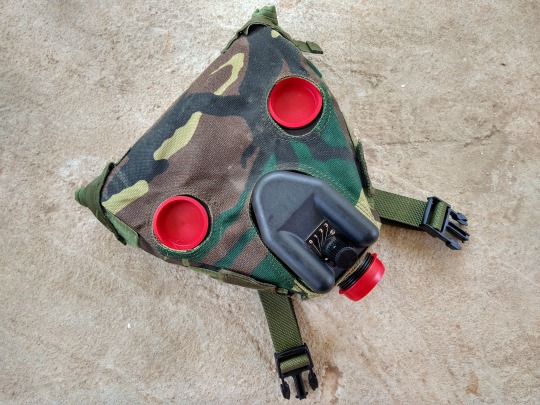

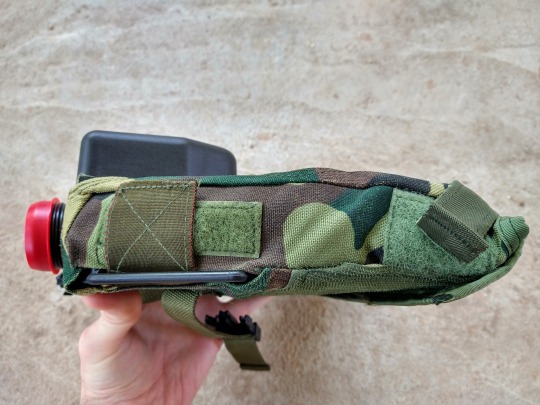
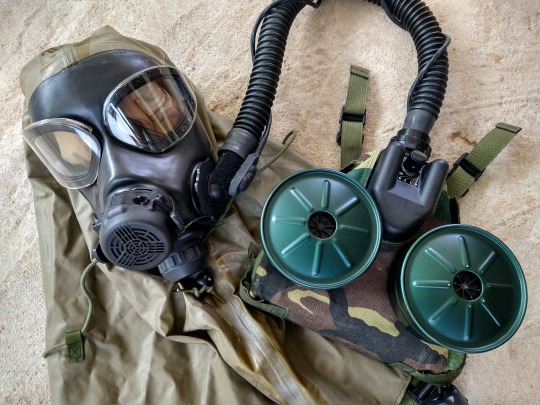
AWS Inc. 65304 'SCBA Blower Cover', Woodland Camo
Seen in a famous ref pic of CAG during CBRN Training c.2002-2004, haphazardly mounted with cable ties to a Paraclete RAV Zip-Off MOLLE Panel , as these were presumably intended to be mounted to an SCBA Bottle Cover originally.
Been hunting for one of these for ages, and the last piece of the CAG CBRN puzzle is now in place.
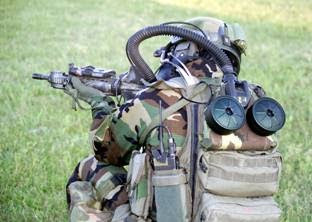
^The aforementioned reference.
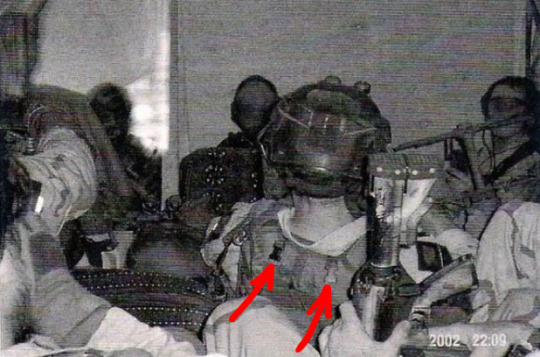
^Some RAV's were even occasionally modded with buckles to accommodate these blower pouches, as seen in this photo.
2 notes
·
View notes
Text






U.S. Marines assigned to Chemical Biological Radiological and Nuclear (CBRN) Defense School provide security for the combat operations center during a field training exercise at Fort Leonard Wood, Mo.
Lance Cpl. Manuel Serrano / US Marines, May 12, 2016
7 notes
·
View notes
Text

Art by MinisterOvVox on Twitter/X
“The battle always comes down to the Infantryman and his rifle”
The infantryman is the core to any military and nearly all other functions of the military are in support of the infantry’s mission; to close with and destroy the enemy. This is no different for the Shaconage Republic.
The Shaconage Republic infantryman is intimately familiar with small unit tactics, the fundamentals of maneuver warfare, is trained to act as a guerrilla in asymmetric warfare, and is just as familiar with bush craft and field craft as he is with tactics. On Shaconage, your ability to survive in the wilderness is vital to not just your immediate survival, but your success in tactical operations in the wilderness. They are just as skilled with their survival tools as they are with their weapons and mission equipment.
Despite their equipment not being as advanced as that of some of their more technologically advanced and better funded counterparts such as New Athens, Hoplities, the Azen Empire, and the Terran Federation, they make up for those short comings with their ingenuity, adaptability, their intensive training, and their tough physical standards and capabilities.
Every soldier and marine that joins the military is required to undergo infantry training and comprehensive survival training on top of their individual training. Infantrymen in the army and marines go through additional advanced tactical training and advanced survival training so they can survive long term in the field without resupply. Each infantryman is also trained to move through various environments stealthily in order to enhance their freedom of maneuver in contested or enemy controlled territory as well as to enable each infantryman to be better prepared to act as a scout.
The infantryman is equipped with the Mk 15 MCAR (Magnetic Coil Assisted Rifle), a helmet equipped with a HUD suite with multi spectral IR/Thermal overlay vision, a built in communications suite, CBRN filters, and a variety of other enhancements. They are also equipped with body armor, shoulder plates, thigh plates, ballistic knee pads, and an optical camouflage compact ghillie hood (full ghillie hood not depicted, only an optical camo helmet scrim net).
0 notes
Video
youtube
NATO CBRN defence specialists train with live chemical agents in Czechia At a base in Brno, Czechia, NATO troops have been training with live chemical agents, to prepare for real-world chemical attacks. Live chemical agents were used in a NATO course to test the skills of a group of chemical, biological, radiological and nuclear (CBRN) defence specialists. Using live chemical agents for training is unique to the Joint CBRN Defence Centre of Excellence in Czechia, offering a chance for all 20 participants to experience the psychological challenges involved in handling them. By using actual poisons and nerve agents, rather than simulated non-toxic alternatives, participants must adhere to rigorously precise workflows and protective equipment standards. After five days of exercises and evaluations, the participants leave with the confidence and competence necessary for NATO troops to respond effectively in real CBRN incidents. Footage includes shots of US and Italian course participants, alongside Czech and Swedish instructors, training on simulated and live chemical agents plus soundbites from Colonel Michael Firmin, Education, Training and Evaluation Department Director at the Joint CBRN Defence Centre of Excellence, Warrant Officer Roman Schindler, chief course instructor, and Senior Warrant Officer Mikael Isaksson, course instructor. #nato #natoallies #Czech #Swedish #chemical #czechia #cbrn #CBRNIncidents #Training #Military #chechnya #radioactive #biological #weapons #military #Alliedforces #NATOtraining #weapon #chemicalweapons #defence
0 notes
Text
EMT Hazmat Training Program at Signet North America: Life-Saving Skills for Medical Teams
In the high-stakes world of emergency medical services (EMS), being prepared for every possible scenario is crucial. That's where EMT Hazmat Training comes into play. Offered by Signet North America, this training equips medical teams with specialized skills to handle hazardous materials (Hazmat) emergencies, playing a pivotal role in saving lives and ensuring safety in critical situations.
Understanding the Importance of EMT Hazmat Training
Why is EMT Hazmat Training crucial? Imagine responding to an emergency involving chemical spills, biological threats, or toxic substances. Without the right training, such situations can be overwhelming and dangerous—not just for the victims but also for the responders themselves. EMT Hazmat Training provides essential knowledge and skills, enabling medical teams to assess risks accurately and respond effectively.
Real-Life Scenarios
Consider this scenario: A factory reports a chemical leak, and workers have symptoms of severe exposure. An EMT team trained in Hazmat protocols can quickly identify the potential hazards, commence decontamination procedures, and provide immediate care while ensuring their safety. Such preparedness minimizes chaos, reduces health risks, and often spells the difference between life and death.
Components of the EMT Hazmat Training Program
The Signet North America EMT Hazmat Training Program is designed to be comprehensive, covering various crucial aspects to ensure well-rounded preparedness.
1. Hazard Recognition and Risk Assessment
Training begins with hazard recognition—learning to identify different types of hazardous materials and understanding the risks associated with them. This component involves studying material data sheets, understanding labeling systems like NFPA and GHS, and recognizing environmental indicators of Hazmat presence.
2. Protective Measures and Equipment
Next, the program emphasizes the importance of personal protective equipment (PPE). Participants become familiar with selecting and using appropriate PPE—ranging from gloves and masks to full-body suits—based on the level of hazard present.
3. Decontamination Procedures
Decontamination is a critical procedure in Hazmat situations. Training covers both emergency decontamination (for immediate threats) and technical decontamination, ensuring that contaminants are safely and effectively removed from personnel and victims.
Technique Highlight
Participants practice setting up decontamination showers and use specialized techniques to prevent cross-contamination, protecting both the environment and human health.
4. Medical Response and Patient Care
Handling patients exposed to hazardous materials requires specialized medical knowledge. The program includes modules on symptoms of different exposures, appropriate medical interventions, and the psychological impact of Hazmat incidents.
Patient Care Strategy
Trainees learn to administer treatments specific to chemical, biological, radiological, and nuclear (CBRN) threats, ensuring comprehensive care under pressure.
Benefits of Training with Signet North America
Professional Expertise and State-of-the-Art Facilities
Signet North America brings unparalleled expertise and modern training facilities to the table. Their trainers are industry veterans who have worked in live Hazmat situations, providing invaluable insights and real-world experience.
Why Choose Signet?
Participants receive hands-on training with cutting-edge equipment, simulating real-life situations to build confidence and competence.
A Commitment to Safety and Excellence
Signet's dedication to client satisfaction shines through their meticulous training approach. They prioritize safety above all, ensuring that every trainee leaves with the knowledge and skills needed to handle Hazmat emergencies efficiently.
Becoming a Part of the Solution
In a world where the unexpected can happen at any moment, being equipped with life-saving skills through the EMT Hazmat Training Program is not just beneficial—it's essential. The expertise and experience gained during this program empower medical teams to respond swiftly and effectively, safeguarding lives and communities.
If you're ready to elevate your skills and join the ranks of highly trained EMT professionals, contact Signet North America today. Call us at 877-875-2921 to learn more about our EMT Hazmat Training Program and schedule your training session. Remember, the life you save with this training could be your own or someone else's. Don't wait—become a part of the solution now!
0 notes
Text
Fun fact
Soldiers are subjected to gas chambers in order to train them how to use gas masks and respond to chemical, biological, radiological, and nuclear threats.
(CBRN) is a fun little acronym to remember it by.
The gas chamber is filled with a concentration of tear gas.
So, this guy didn't flinch bc he's done this before.

0 notes
Text
Militares españoles participan en el ejercicio internacional “Toxic Aggressor” con agentes químicos de guerra reales




Personal del Regimiento de Defensa Nuclear, Biológica y Química (NBQ) “Valencia” nº 1 ha participado, junto con miembros de la Brigada “Rey Alfonso XIII” II de la Legión, de la Escuela Militar de Defensa NBQ y de la Unidad Militar de Emergencias, en el ejercicio “Toxic Aggressor”, celebrado del 16 al 27 de septiembre, en las instalaciones del Centar ABHO (CBRN CENTRE) de la localidad de Krusevac (Serbia). Se ha tratado de un ejercicio tipo Live Agent Training (LAT), en el que el personal participante se ha instruido en la detección, identificación y toma de muestras de agentes químicos de guerra reales (AQGR). Las maniobras se dividieron en dos fases: básica y avanzada. La primera transcurrió del 16 al 20 de septiembre y estuvo enfocada a la instrucción individual en la detección e identificación de AQGR como la iperita, el sarín, la lewisita o el VX, utilizando para ello detectores como el LCD 3.3 o el AP4C, o identificadores como el First Defender y True Defender. La fase avanzada, del 23 al 27 de septiembre, se centró en el adiestramiento específico para el reconocimiento NBQ, con presencia de AQGR. Así, se realizaron reconocimientos y toma de muestras, para su posterior traslado a un laboratorio de referencia, en escenarios complejos donde se habían empleado dichos agentes, alcanzándose un alto grado de adiestramiento y cohesión de las unidades. Además, en esta fase, se empleó el sistema FALCON 4G, con el que realizaron la identificación de distintos agentes químicos empleados a una distancia de 260 metros. Fuente: Read the full article
0 notes